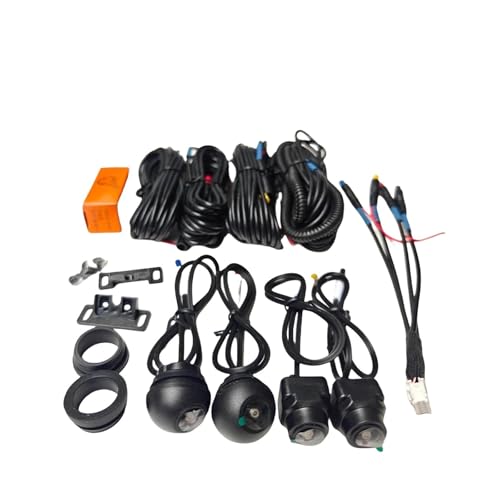Enhancing your driving experience with a 360-degree camera system is a smart way to improve visibility around your car. These systems stitch together images from multiple cameras placed around the vehicle to create a composite bird’s-eye view. This allows you to see every angle around your car, virtually eliminating blind spots and making parking and maneuvering in tight spaces much easier.

Adding a 360 camera to your car is a process that involves a few careful considerations. First, it’s essential to determine if your vehicle is compatible with an aftermarket 360-degree camera system. Once compatibility is confirmed, selecting the right camera kit that fits your needs and budget comes next. The installation process typically requires some technical know-how, but with the right tools and a bit of patience, it’s a task that can often be accomplished at home.
Key Takeaways
- Installing a 360 camera improves visibility and safety while driving.
- Ensuring vehicle compatibility and selecting the right system are crucial steps.
- Proper installation and calibration are key for optimal system performance.
Understanding 360-Degree Camera Systems
Adding a 360-degree camera system to your car infuses cutting-edge technology that significantly enhances safety and maneuvering capabilities. Let’s explore the intricacies of these systems and their impact on your driving experience.
Benefits for Safety and Maneuvering
The primary advantage of a 360-degree camera system—also known as a surround-view camera—is the comprehensive perspective it provides. This technology stitches together footage from multiple cameras placed around your vehicle, giving you a bird’s-eye view. This visibility drastically reduces blind spots, making parking in tight spots and navigating through crowded places safer and more intuitive. It turns into your extra set of eyes, significantly enhancing your safety while driving.
Components of a 360 System
At the heart of a 360 system lies a network of cameras typically mounted at the front, rear, and sides of your car. These are then connected to a display that offers the panoramic view. Moreover, essential components such as image processing software amalgamate the separate images to create a seamless view around your vehicle. This integrated approach ensures that you have a full view around your car without any manual effort to switch between different camera feeds.
Comparing OEM and Aftermarket Options
When it comes to installation, you have two main pathways—OEM (Original Equipment Manufacturer) and aftermarket systems. OEM systems are usually pre-installed in newer vehicles, offering a solution that’s specifically designed for your car model, ensuring optimal integration and functionality. Aftermarket systems can be installed in almost any vehicle, providing a versatile alternative to enhance an older car with this modern technology. While considering an aftermarket 360 car camera system, check for compatibility with your vehicle and prefer quality brands that provide clarity and reliability.
Assessing Vehicle Compatibility

Before deciding to upgrade your vehicle with a 360-degree camera system, it’s essential to determine if your car is compatible with this technology. Compatibility varies between original equipment manufacturer (OEM) systems and aftermarket kits.
Types of Compatible Vehicles
- Large Vehicles: You’ll find that large vehicles like SUVs and trucks often have OEM options for 360-degree camera systems due to their size and the increased difficulty of visibility.
- Aftermarket Kits: Most vehicles, however, can be equipped with aftermarket 360-degree camera kits. Compatibility largely depends on the specific model and the available space for camera installation.
Space and Mounting Requirements
- Space: Ensure your vehicle has enough space at key points—front, rear, and sides—for camera installation without obstructing essential components or visibility.
- Mounting: Aftermarket kits should provide various mounting options suitable for your car’s design, whether it’s a flush mount on the bumper or a bracket mount on the side mirrors.
Remember, for successful integration of a 360-degree camera system, your vehicle’s compatibility with either OEM options or aftermarket kits is crucial, as is the availability of proper space for mounting the cameras.
Selecting the Right 360 Camera
When you’re considering adding a 360-degree camera to your vehicle, the selection process is crucial. You’ll want to evaluate camera quality and features while being mindful of the price range that fits your budget.
Key Features to Consider
- Field of View: Ensure the camera system has a full 360-degree field to maximize visibility.
- Compatibility: Your camera should be compatible with your car’s make and model.
- User Interface: Look for a system with an intuitive user-friendly interface.
- Installation Requirements: Some systems are plug-and-play, while others may require professional installation.
Understanding Camera Quality and Resolution
- Resolution: Higher resolution in a camera offers clearer, more detailed images. Aim for cameras that provide at least 1080p.
- Camera Quality: Read reviews and compare models to gauge the reliability and performance in various lighting conditions and driving circumstances.
Remember to balance between camera quality, feature set, and the price range to find the camera system that best fits your needs.
Preparation for Installation

Before adding a 360 camera to your car, it’s crucial to prepare properly to ensure a smooth installation process. You’ll need to gather the right tools and understand the safety precautions to protect both your vehicle and yourself.
Gathering Necessary Tools and Accessories
To install a 360 camera in your car, you’ll require:
- Screwdriver set: For removing panels and securing the mount.
- Trim removal tools: To pry open vehicle interior without causing damage.
- Camera kit with wiring and mount: Ensure compatibility with your vehicle make and model.
- Electrical tape or heat shrink tubing: For secure wire connections.
- Multimeter (optional): To check electrical connections.
« How Does a 360 Car Camera Work? Unraveling the Technology Behind the Scenes
Best 360 Camera Systems for Cars: Top Models for Superior Surround View »
Additionally, make sure you have the camera’s installation manual handy for specific instructions related to your model.
Safety Precautions Before Installation
Your safety is paramount during installation:
- Disconnect the battery: Prevent electrical shorts and protect the car’s electronic systems.
- Wear protective gear: Consider safety glasses and gloves when dealing with wires and electronics.
- Be mindful of airbags: Avoid working near airbag connectors to prevent accidental deployment.
Remember, taking the time to prepare can lead to a successful addition of a 360 camera to your car and potentially, a more secure driving experience.
Installation Steps
Installing a 360 camera in your car involves a few key steps to ensure that you get the broadest field of vision and optimal functionality. You’ll be mounting cameras, managing wiring, and calibrating the system to work correctly with your car’s display.
Mounting Cameras on Strategic Points
To create a seamless surround view, you’ll mount cameras at strategic points on your vehicle. Typically, one on the front grille allows you to see obstacles in front of your car. Cameras on the side mirrors give you a view of the left and right sides of your car, and another at the rear captures everything behind you. It’s crucial that these cameras are positioned to provide a comprehensive 360-degree field of vision without any blind spots.
Wiring and Power Considerations
Every camera needs a power source, and it’s essential to wire them correctly to ensure constant operations. The wires should be routed neatly, avoiding places where they might get pinched or damaged. You’ll connect the cameras to the car’s power system, often tapping into the wiring of the backup lights or interior lighting, so they turn on automatically when you start your car or engage reverse.
Calibrating Your 360 Camera System
Once the cameras are mounted and wired, camera calibration is crucial. Calibration aligns the camera angles to stitch together a cohesive surround view camera system. This process might involve software provided by your camera system manufacturer, and it’s typically done through an on-screen guide or a smartphone app. Follow the instructions carefully to ensure accuracy and the best possible functionality of your 360 cameras.
Calibration and Testing
Once you’ve installed your 360 camera system, the next crucial steps are calibration and testing to ensure that you’re getting the perfect surround view. By properly adjusting each camera and syncing them, you’ll be able to achieve a real-time, bird’s-eye view of your car’s surroundings without distortion or blind spots.
Adjusting Camera Angles for Optimal View
To maximize the effectiveness of your surround view system, it’s important to adjust the camera angles. This ensures each camera’s lens is positioned to capture a clear and comprehensive view. Start by tilting and panning each camera until there’s a slight overlap in the feeds. This overlap is essential for creating a seamless panoramic image.
- Front/Rear Cameras: Aim for a downward angle that captures the bumper and some of the surrounding area.
- Side Cameras: Position these so they can capture the sides of your car and blend slightly with the front and rear camera views.
Ensuring Camera Synchronization
Your system comprises multiple cameras that must work in harmony to generate a cohesive surround view. Synchronize the camera feeds in real-time by carefully following your camera system’s calibration steps—this usually involves specific software provided by your camera manufacturer.
- Timing: Ensure all cameras are recording and displaying in sync to prevent any lag or discrepancies in the combined view.
- Software Calibration: Use the calibrating software to fine-tune the stitching of images, making for a seamless and continuous panoramic view.
While technical details may vary depending on the camera brand and model, striving for precise angles and synchronization will deliver an accurate real-time view and aid tremendously in driving safety.
Integrating with the Infotainment System
Integrating a 360 camera with your car’s infotainment system enhances your visibility and control, offering a seamless top view of your surroundings. This can be a significant safety upgrade for your vehicle.
Display Options for the Live Feed
The infotainment screen in your car serves as the primary interface for the 360 car camera system. Here’s how to harness it for the best results:
- Full-Screen Mode: Switch to this mode to fill your infotainment screen with the camera feed, maximizing visibility.
- Split-Screen Mode: This mode allows you to view the camera feed alongside other infotainment functions, like navigation or audio controls.
You can usually toggle between these display options either through touch controls or physical buttons on your infotainment system.
Customizing User Settings
Your infotainment system should allow for customization of your 360 camera settings to suit your preferences:
Adjust Camera Angles:
- Top View: To focus on a bird’s-eye view, select this as your preferred angle through the settings menu.
- Side or Rear Views: Highlight the sides or back of your car if those areas require more attention.
Set Default View:
- Choose which camera view automatically activates when you start your car or switch to reverse.
Navigate to the settings section on your infotainment screen to make these adjustments. Remember, these changes aim to enhance the functionality and user-friendliness of your 360 camera system.
Enhancing Parking Capability
Adding a 360 camera to your car can revolutionize the way you handle parking. This upgrade gives you a comprehensive view of your surroundings, making it effortless to maneuver into any parking spot.
Utilizing Top-Down and Overhead Views
With a 360-degree camera system, you can get a top-down view of your vehicle, which displays a bird’s-eye perspective. This view is particularly helpful because it shows all four sides of your car as if you were looking down from above. When you’re sliding into a parking spot, the overhead view makes it easy to see the lines and judge the distance between your car and those around you.
Benefits:
- Increased Visibility: See more than what your mirrors show.
- Precision Parking: Makes aligning your car within the spot precise.
Interfacing with Existing Parking Sensors
If your car is already equipped with parking sensors, integrating your new 360 camera will enhance their functionality. The camera’s visuals can be aligned with the sensor’s alerts, providing not just an audible warning but also a visual cue on your screen of how close you are to objects. This integration helps prevent bumps and scrapes and can guide you into even the tightest spaces with confidence.
How it works:
- Visualizing Sensor Data: The camera feed includes graphics that change color or intensity as you get closer to obstacles.
- Complementary Systems: While parking sensors give you proximity alerts, the camera gives you the visual context.
Maintaining and Troubleshooting

When adding a 360-degree camera to your car, it’s essential to keep up with maintenance and know how to troubleshoot common issues to ensure its longevity and optimal functionality. Let’s break down the steps you should take and the fixes for typical problems you might encounter.
Regular Maintenance Tips
- Check Camera Lenses: Periodically wipe your camera lenses with a soft, clean cloth to ensure they provide a clear view. Dust and dirt can accumulate, significantly reducing visibility.
- Software Updates: Always keep the camera system’s software up to date. Manufacturers may release updates that improve performance or add new features.
- Inspect Wiring Connections: Make certain that the wiring connections are secure. Vibration from your car can sometimes loosen connections, leading to malfunctions.
- Review Warranty Terms: It’s wise to be familiar with the terms of your warranty in case service is required. Knowing what is covered can save you both time and money.
Common Issues and Fixes
- Camera Not Powering On: First, check the fuse associated with your surround-view camera system. If the fuse is intact, inspect the power connections to the camera.
- Distorted Image: If the image from your wide-angle cameras appears distorted, it could be a result of dirty lenses or a malfunctioning camera. Cleaning the lens is a straightforward fix, while camera issues may require professional assistance.
- System Error Messages: When facing persistent error messages, a system reset may rectify minor software hiccups. Refer to your owner’s manual for the correct procedure to reset your camera system.
- Poor Stitching of Camera Feeds: The system relies on seamless integration of feeds from multiple cameras. Calibration may be necessary if the stitching seems off. This process can sometimes be done through the camera settings in your vehicle’s infotainment system.
Remember, approaching maintenance and troubleshooting with a friendly and proactive mindset will go a long way in keeping your camera system running smoothly.
Exploring Advanced Features
When you upgrade your car with a 360 camera system, you’re not just getting a simple parking aid. This advanced technology offers a range of features that integrate with your vehicle’s systems, enhancing your overall driving experience.
Smart Technology Integration
Your 360 camera system isn’t a standalone gadget; it’s designed to work in tandem with your car’s existing tech. This integration can include linking up with your infotainment screen, offering you a seamless interface. With bird’s eye view capability, you gain a comprehensive perspective of your car’s environment, which can be critical in tight parking situations or when navigating through complex traffic conditions.
Additional Capabilities Beyond Parking Assistance
Aside from helping with parking, a 360 camera system brings additional functionalities to the table:
- Dynamic Guidelines: When you turn the steering wheel, some systems project the vehicle’s path onto the screen, adjusting in real-time.
- Cross Traffic Alerts: Be aware of approaching vehicles from the side, which is particularly helpful when backing out of a driveway or a parking space.
Keep in mind that automakers often offer different options tailored to their vehicles, so it’s wise to check compatibility and features specific to your brand. This technology is constantly evolving, considering the environment and how your car interacts with it, giving you an edge in safety and convenience.
Frequently Asked Questions
When looking to upgrade your vehicle with a 360-degree camera system, you likely have questions regarding installation, costs, integration with current systems, key features, and the comparison of wired versus wireless setups. Here are concise answers to some of the most common inquiries.
What is the installation process for a 360-degree camera in a vehicle?
The installation process typically involves mounting cameras at strategic points around your vehicle, connecting them to a power source, and integrating the video output with an in-car display. For detailed steps, you can review guides like Driving in 360: Your Ultimate Guide to Installing a Camera in Your Car.
What are the typical costs associated with installing a 360-degree camera in a car?
Costs can vary based on the camera system’s brand and complexity. Basic systems may start around $200, whereas more advanced setups with higher image quality could exceed several hundred dollars. Additional installation fees might apply if you’re not installing it yourself.
Can aftermarket 360-degree cameras be integrated with existing in-car display systems?
Many aftermarket 360-degree cameras are designed to work with existing in-car displays, although you should confirm compatibility before purchasing. Systems like the Weivision 360° Around View Camera System are often designed for easy integration.
What features should I look for when choosing a 360-degree camera kit for my car?
Key features to consider include image quality, night vision capability, parking assistance lines, and whether the system can record footage for security purposes. Some systems offer added functionalities like loop recording on a micro SD card as described in How Does 360 Car Camera Work.
How do wireless 360-degree car cameras compare to wired systems in terms of reliability and performance?
Wireless systems offer easier installation and less invasive setup but may suffer from interference or a less reliable signal compared to wired systems. Wired systems typically provide more stable and consistent image transmission.
Are there specific models of 360-degree cameras recommended for use in car racing applications?
For car racing, robust models that can withstand high speeds and vibration while offering real-time feed and high frame rates are recommended. These may also include features like shock resistance, as performance is critical in such applications.















